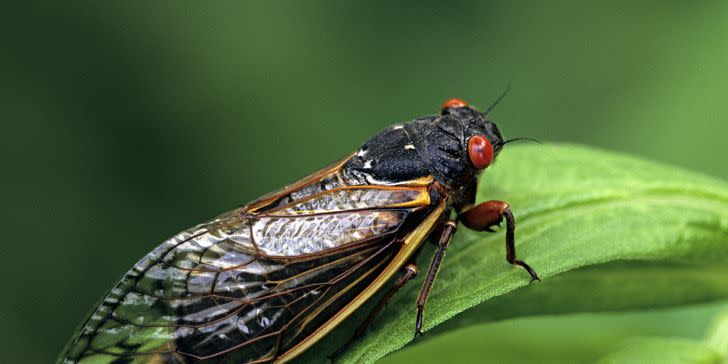The Brood X Cicadas Are Coming This Spring. Here's Everything You Need to Know

You’ve probably heard all the hype about the most recent cicada emergence, Brood X, which is estimated to number in the trillions (yes, you read that correctly!). But what exactly does it all mean? “Starting sometime in April or May, depending on where you live, one of the largest broods of 17-year periodical cicadas will emerge from the ground,” says Chris Simon, PhD, professor of Ecology and Evolutionary Biology at the University of Connecticut. “As a species, they’re older than the forests they inhabit, and they’re unique in that most of the members of the population emerge in one year and then are absent in intervening years.”
Here’s every other fascinating fact about this natural phenomenon.
What are periodical cicadas?
Periodical cicadas, which are about an inch long, hatch in groups, called “broods,” on a regular 13- or 17-year cycle. Stragglers sometimes show up during the in-between years. The large numbers that appear at once help them find mates and survive predators. Early American colonists even experienced a cicada emergence and thought they were Biblical plague of locusts, but locusts actually are a type of grasshopper.
So, what have these cicadas been doing for the past 17 years?
Underground, cicadas feed on plant roots and pass through five juvenile stages before it’s time to make an appearance above-ground to find a mate.
Many eastern states will see periodical cicadas this year.
These unique insects will be found in the easternmost U.S. from Long Island to northern Georgia and into the Midwest. Check out the map here. As many as 1.5 million cicadas can emerge in one acre, so, yes, that’s impressive! But populations are unpredictable, so you might see tons of them in your neighborhood—or none at all, says Simon.
After all those years underground, they’ll appear as adults for about 4 weeks or so, looking for mates. The females will lay hundreds of eggs in tree branches. Then the adults die, the eggs hatch, the nymphs fall to the ground and burrow back into the earth, starting the cycle again.
Are cicadas dangerous?
Absolutely not! Their buzzing hum is loud, especially about a week and a half after you first spot them. But the din of their choruses (yes, that’s what their songs are called when they’re all singing together!) only lasts a couple weeks. As a group, their songs may reach 90 decibels. Though they’re sometimes attracted to the noise of machinery such as lawn mowers, they don’t bite or sting humans and they’re not poisonous, says Simon. And cicadas also don’t destroy crops or fly around in swarms.
You should protect young trees from periodical cicadas.
If you’ve recently planted trees or shrubs, cover them with bird netting, advises Simon. Even though periodical cicadas don’t chew on crops, they can cause physical damage if too many insects lay eggs in small branches. Mature trees and shrubs usually survive even dense populations, though they may have lots of broken brown twigs in the weeks following an emergence. Periodical cicadas generally leave annuals and perennials alone, except to land on them after first emerging from the ground.
Is it okay if my dog eats cicadas?
Probably not. While one or two likely won't hurt, their crunchy exoskeleton could present a choking hazard. And cicadas may cause digestive upset, vomiting, or diarrhea if too many are eaten. Bottom line: It’s best to prevent your pets from noshing on them (both when alive or dead!). Contact your vet if you have any concerns.
What should I do with the cicadas?
Help scientists log them by downloading the free mapping app, Cicada Safari. And enjoy the spectacle! As for all the crunchy shells, called “husks,” that remain sticking to trees and blowing around your garden, sweep them, compost them, or leave them for nature to decompose. And wait for their next appearance in 17 years!
You Might Also Like

